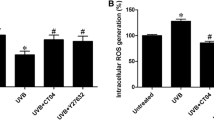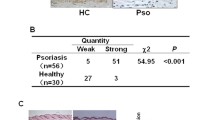Abstract
Bullous pemphigoid (BP) is the most common subepidermal autoimmune blistering skin disease characterized by autoantibodies against the hemidesmosomal proteins BP180 and BP230. The cell stress chaperone heat shock protein 90 (Hsp90) has been implicated in inflammatory responses, and recent evidence suggests that it represents a novel treatment target in autoimmune bullous diseases. The aim of the study was to investigate the contribution of Hsp90 to the proinflammatory cytokine production in keratinocytes induced by autoantibodies to BP180 from BP patient serum. HaCaT cells were treated with purified human BP or normal IgG in the absence or presence of the Hsp90 blocker 17-DMAG and effects on viability, interleukin 6 (IL-6) and IL-8 (cytokines critical for BP pathology), NFκB (their major transcription factor), and Hsp70 (marker of effective Hsp90 inhibition and potent negative regulator of inflammatory responses) were investigated. We found that BP IgG stimulated IL-6 and IL-8 release from HaCaT cells and that non-toxic doses of 17-DMAG inhibited this IL-8, but not IL-6 secretion in a dose- and time-dependent fashion. Inhibition of this IL-8 production was also observed at the transcriptional level. In addition, 17-DMAG treatment blunted BP IgG-mediated upregulation of NFκB activity and was associated with Hsp70 induction. This study provides important insights that Hsp90 is involved as crucial regulator in anti-BP180 IgG-induced production of keratinocyte-derived IL-8. By adding to the knowledge of the multimodal anti-inflammatory effects of Hsp90 blockade, our data further support the introduction of Hsp90 inhibitors into the clinical setting for treatment of autoimmune diseases, especially for BP.






Similar content being viewed by others
References
Ambade A, Catalano D, Lim A, Mandrekar P (2012) Inhibition of heat shock protein (molecular weight 90 kDa) attenuates proinflammatory cytokines and prevents lipopolysaccharide-induced liver injury in mice. Hepatology 55:1585–1595
Chen R, Ning G, Zhao ML et al (2001) Mast cells play a key role in neutrophil recruitment in experimental bullous pemphigoid. J Clin Invest 108:1151–1158
Collins CB, Aherne CM, Yeckes A et al (2013) Inhibition of N-terminal ATPase on HSP90 attenuates colitis through enhanced Treg function. Mucosal Immunol 6:960–971
Dakappagari N, Neely L, Tangri S et al (2010) An investigation into the potential use of serum Hsp70 as a novel tumour biomarker for Hsp90 inhibitors. Biomarkers 5:31–38
de Jong PR, Schadenberg AW, Jansen NJ, Prakken BJ (2009) Hsp70 and cardiac surgery: molecular chaperone and inflammatory regulator with compartmentalized effects. Cell Stress Chaperones 14:117–131
Defee MR, Qin Z, Dai L, Toole BP, Isaacs JS, Parsons CH (2011) Extracellular Hsp90 serves as a co-factor for NF-κB activation and cellular pathogenesis induced by an oncogenic herpes virus. Am J Cancer Res 1:687–700
Dello Russo C, Polak PE, Mercado PR et al (2006) The heat-shock protein 90 inhibitor 17-allylamino-17-demethoxygeldanamycin suppresses glial inflammatory responses and ameliorates experimental autoimmune encephalomyelitis. J Neurochem 99:1351–1362
Feyerabend TB, Weiser A, Tietz A et al (2011) Cre-mediated cell ablation contests mast cell contribution in models of antibody- and T cell-mediated autoimmunity. Immunity 35:832–844
Gürcan HM, Ahmed AR (2009) Efficacy of dapsone in the treatment of pemphigus and pemphigoid: analysis of current data. Am J Clin Dermatol 10:383–396
Han JM, Kwon NH, Lee JY et al (2010) Identification of gp96 as a novel target for treatment of autoimmune disease in mice. PLoS One 5:e9792
Henderson B, Kaiser F (2013) Do reciprocal interactions between cell stress proteins and cytokines create a new intra-/extra-cellular signalling nexus? Cell Stress Chaperones 18:685–701
Hoffmann E, Dittrich-Breiholz O, Holtmann H, Kracht M (2002) Multiple control of interleukin-8 gene expression. J Leukoc Biol 72:847–855
Inaoki M, Takehara K (1998) Increased serum levels of interleukin (IL)-5, IL-6 and IL-8 in bullous pemphigoid. J Dermatol Sci 16:152–157
Kasperkiewicz M, Zillikens D (2007) The pathophysiology of bullous pemphigoid. Clin Rev Allergy Immunol 33:67–77
Kasperkiewicz M, Müller R, Manz R et al (2011) Heat-shock protein 90 inhibition in autoimmunity to type VII collagen: evidence that nonmalignant plasma cells are not therapeutic targets. Blood 117:6135–6142
Kim JM, Lee DH, Kim JS et al (2009) 5,7-Dihydroxy-3,4,6-trimethoxyflavone inhibits the inflammatory effects induced by Bacteroides fragilis enterotoxin via dissociating the complex of heat shock protein 90 and I kappaB alpha and I kappaB kinase-gamma in intestinal epithelial cell culture. Clin Exp Immunol 155:541–551
Kobayashi Y (2008) The role of chemokines in neutrophil biology. Front Biosci 13:2400–2407
Lang SA, Moser C, Gaumann A et al (2007) Targeting heat shock protein 90 in pancreatic cancer impairs insulin-like growth factor-I receptor signaling, disrupts an interleukin-6/signal-transducer and activator of transcription 3/hypoxia-inducible factor-1alpha autocrine loop, and reduces orthotopic tumor growth. Clin Cancer Res 13:6459–6468
Liu Z, Giudice GJ, Zhou X et al (1997) A major role for neutrophils in experimental bullous pemphigoid. J Clin Invest 100:1256–1263
Messingham KN, Srikantha R, DeGueme AM, Fairley JA (2011) FcR-independent effects of IgE and IgG autoantibodies in bullous pemphigoid. J Immunol 187:553–560
Mitsiades CS, Mitsiades NS, McMullan CJ et al (2006) Antimyeloma activity of heat shock protein-90 inhibition. Blood 107:1092–1100
Nelson KC, Zhao M, Schroeder PR et al (2006) Role of different pathways of the complement cascade in experimental bullous pemphigoid. J Clin Invest 116:2892–2900
Petersen AL, Guedes CE, Versoza CL et al (2012) 17-AAG kills intracellular Leishmania amazonensis while reducing inflammatory responses in infected macrophages. PLoS One 7:e49496
Rice JW, Veal JM, Fadden RP et al (2008) Small molecule inhibitors of Hsp90 potently affect inflammatory disease pathways and exhibit activity in models of rheumatoid arthritis. Arthritis Rheum 58:3765–3775
Salminen A, Paimela T, Suuronen T, Kaarniranta K (2008) Innate immunity meets with cellular stress at the IKK complex: regulation of the IKK complex by HSP70 and HSP90. Immunol Lett 117:9–15
Sato N, Yamamoto T, Sekine Y et al (2003) Involvement of heat-shock protein 90 in the interleukin-6-mediated signaling pathway through STAT3. Biochem Biophys Res Commun 300:847–852
Schmidt E, Zillikens D (2013) Pemphigoid diseases. Lancet 381:320–332
Schmidt E, Ambach A, Bastian B, Bröcker EB, Zillikens D (1996a) Elevated levels of interleukin-8 in blister fluid of bullous pemphigoid compared with suction blisters of healthy control subjects. J Am Acad Dermatol 34:310–312
Schmidt E, Bastian B, Dummer R, Tony HP, Bröcker EB, Zillikens D (1996b) Detection of elevated levels of IL-4, IL-6, and IL-10 in blister fluid of bullous pemphigoid. Arch Dermatol Res 288:353–357
Schmidt E, Reimer S, Kruse N et al (2000) Autoantibodies to BP180 associated with bullous pemphigoid release interleukin-6 and interleukin-8 from cultured human keratinocytes. J Investig Dermatol 115:842–848
Schmidt E, Reimer S, Kruse N, Bröcker EB, Zillikens D (2001) The IL-8 release from cultured human keratinocytes, mediated by antibodies to bullous pemphigoid autoantigen 180, is inhibited by dapsone. Clin Exp Immunol 124:157–162
Shimp SK 3rd, Chafin CB, Regna NL et al (2012a) Heat shock protein 90 inhibition by 17-DMAG lessens disease in the MRL/lpr mouse model of systemic lupus erythematosus. Cell Mol Immunol 9:255–266
Shimp SK 3rd, Parson CD, Regna NL et al (2012b) HSP90 inhibition by 17-DMAG reduces inflammation in J774 macrophages through suppression of Akt and nuclear factor-κB pathways. Inflamm Res 61:521–533
Sigala I, Zacharatos P, Toumpanakis D et al (2011) MAPKs and NF-κB differentially regulate cytokine expression in the diaphragm in response to resistive breathing: the role of oxidative stress. Am J Physiol Regul Integr Comp Physiol 300:R1152–R1162
Stocki P, Dickinson AM (2012) The immunosuppressive activity of heat shock protein 70. Autoimmune Dis 2012:617213
Taipale M, Jarosz DF, Lindquist S (2010) HSP90 at the hub of protein homeostasis: emerging mechanistic insights. Nat Rev Mol Cell Biol 11:515–528
Teruya H, Higa F, Akamine M et al (2007) Mechanisms of Legionella pneumophila-induced interleukin-8 expression in human lung epithelial cells. BMC Microbiol 7:102
Tukaj S, Kleszczyński K, Vafia K et al (2013) Aberrant expression and secretion of heat shock protein 90 in patients with bullous pemphigoid. PLoS One 8:e70496
Van den Bergh F, Eliason SL, Burmeister BT, Giudice GJ (2012) Collagen XVII (BP180) modulates keratinocyte expression of the proinflammatory chemokine, IL-8. Exp Dermatol 21:605–611
Wax S, Piecyk M, Maritim B, Anderson P (2003) Geldanamycin inhibits the production of inflammatory cytokines in activated macrophages by reducing the stability and translation of cytokine transcripts. Arthritis Rheum 48:541–550
Yeo M, Park HK, Lee KM, Lee KJ, Kim JH, Cho SW (2004) Blockage of HSP 90 modulates Helicobacter pylori-induced IL-8 productions through the inactivation of transcriptional factors of AP-1 and NF-kappaB. Biochem Biophys Res Commun 320:816–824
Yun TJ, Harning EK, Giza K et al (2011) EC144, a synthetic inhibitor of heat shock protein 90, blocks innate and adaptive immune responses in models of inflammation and autoimmunity. J Immunol 186:563–575
Acknowledgments
This work was supported by Deutsche Forschungsgemeinschaft (DFG) Excellence Cluster “Inflammation at Interfaces” (EXC 306/2), DFG KA 3438/1-1, Medical Faculty of the University of Lübeck (E22-2013), and Focus Program “Autoimmunity” at the University of Lübeck.
Author information
Authors and Affiliations
Corresponding author
Rights and permissions
About this article
Cite this article
Tukaj, S., Grüner, D., Zillikens, D. et al. Hsp90 blockade modulates bullous pemphigoid IgG-induced IL-8 production by keratinocytes. Cell Stress and Chaperones 19, 887–894 (2014). https://doi.org/10.1007/s12192-014-0513-8
Received:
Revised:
Accepted:
Published:
Issue Date:
DOI: https://doi.org/10.1007/s12192-014-0513-8




